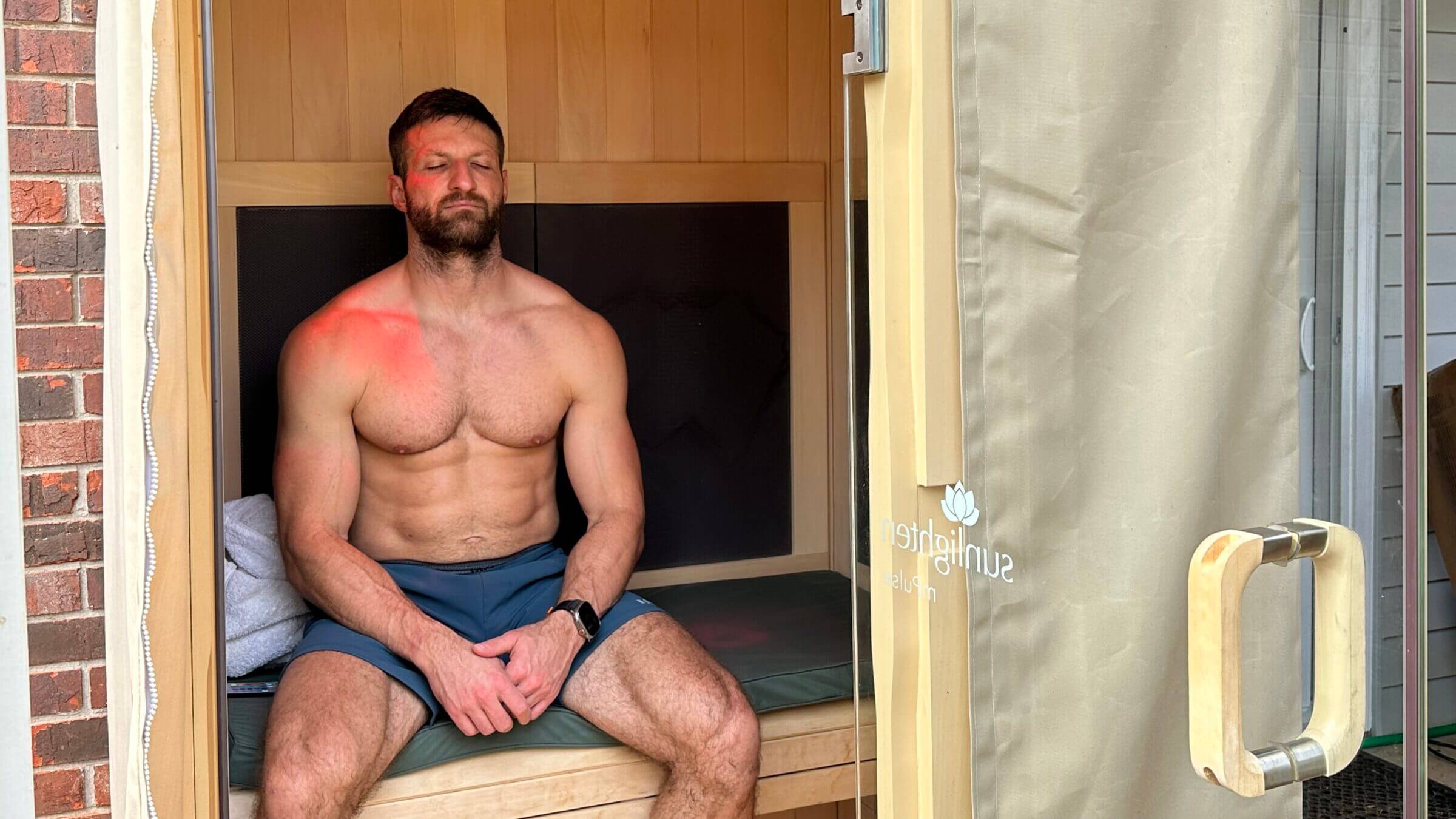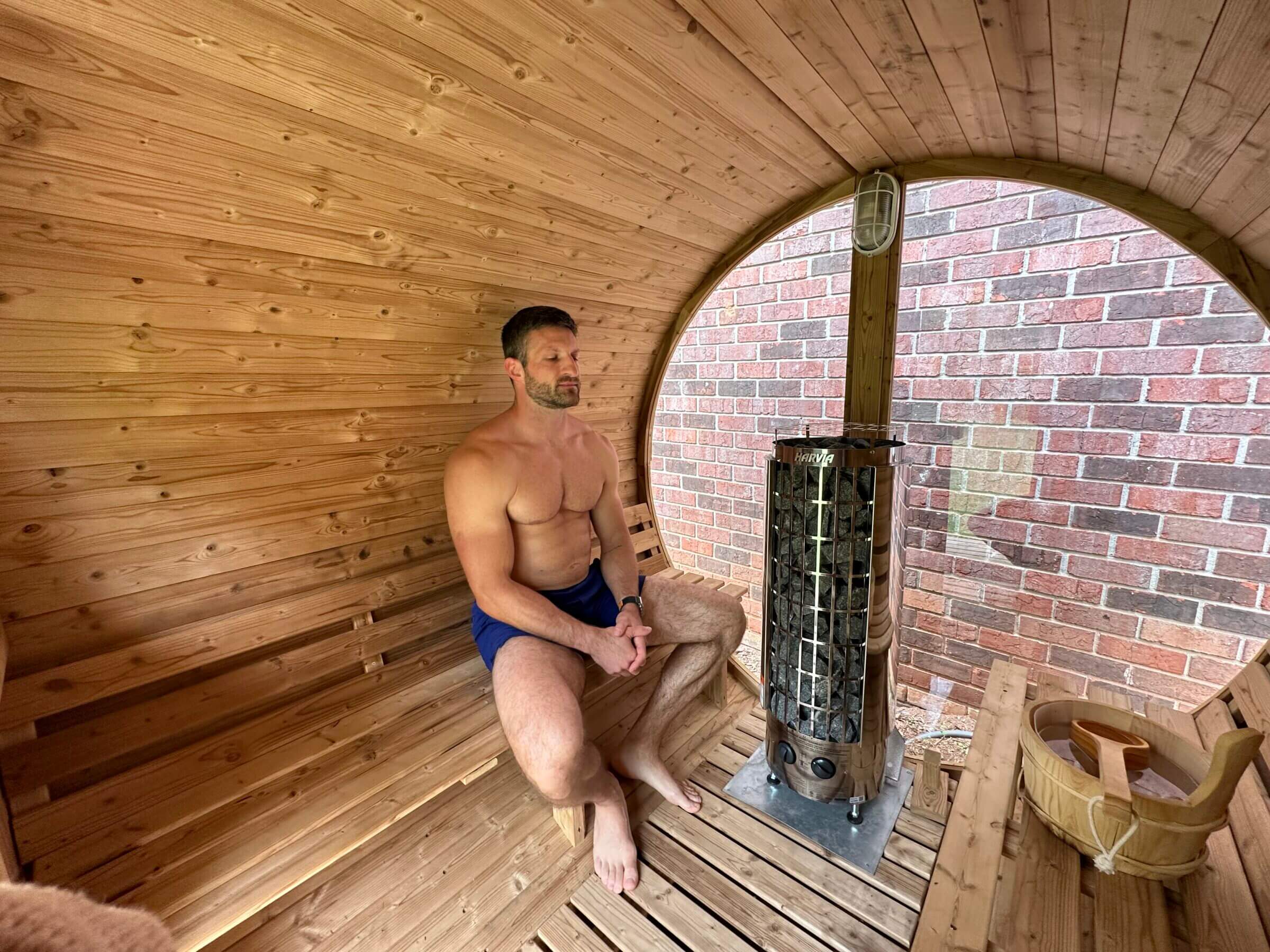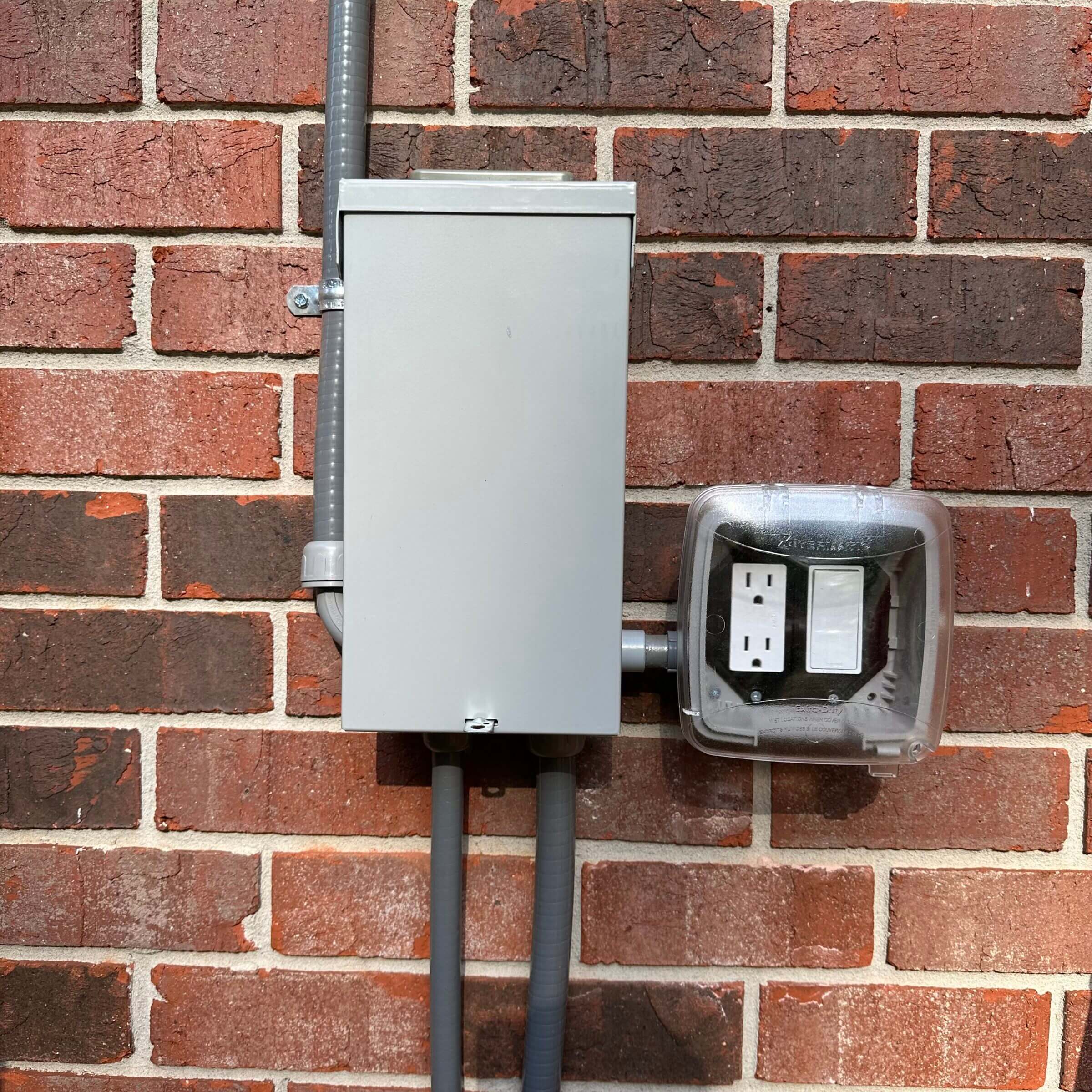While sauna bathing has several scientifically-proven health benefits, there is an ongoing debate about whether traditional steam saunas or infrared saunas are more effective.
As is often the case, the answer depends on the kind of experience and results you’re looking for. In fact, I own both a full-spectrum infrared sauna and a traditional steam sauna, and I utilize them in different use cases.
In this article, I’ll share my take on the infrared vs. steam sauna debate, based on both the latest scientific evidence and my hands-on experience.
Preface: Heat, Humidity and Temperature

Steam saunas typically operate at much higher temperatures and humidity levels than infrared saunas, and their proponents often argue that this fact translates into greater health benefits.
However, it’s important to understand that most of the health benefits associated with intentional heat exposure (such as vasodilation and the release of heat shock proteins) stem from the increase in your body’s core temperature that occurs during sauna use.
Your core temperature rises faster when more heat penetrates your tissue, and infrared radiation is significantly better at deeply penetrating tissue and delivering energy (in the form of heat) into your body than hot air is.
That’s why steam saunas require much higher temperatures than infrared saunas, and why comparing the two sauna types based on their average or maximum temperatures isn’t particularly helpful.
Keep that in mind as we discuss the individual health benefits listed throughout this article.
Key Differences Between Steam and Infrared Saunas
In addition to utilizing different levels of heat and moisture, there are a few important differences between steam and infrared saunas. Here are the most important things to keep in mind when comparing the options.
- Infrared radiation is more effective than steam for reducing pain and increasing blood flow because it can penetrate tissue up to several centimeters.
- Near-infrared light is more effective at improving skin health, promoting collagen production and reducing fine lines and wrinkles than hot air/steam.
- The hot and humid air in Finnish saunas is more effective at helping with respiratory issues because it helps open up airways.
- Infrared saunas are usually more energy efficient than steam saunas that leverage electrical heaters.
- Modern infrared saunas often emit more electromagnetic field radiation (EMF radiation) than simple steam saunas that utilize electrical heaters or wood stoves.
Steam vs. Infrared Saunas: Health Benefits
Steam and infrared saunas support similar, though not identical, health benefits. Here’s a bird’s eye overview of each sauna type’s relative strengths, with more details in the sections below.
| Benefit | Steam Sauna | Infrared Sauna |
|---|---|---|
| Cardiovascular health | ★★★★★ | ★★★★★ |
| Muscle and joint pain relief | ★★★★☆ | ★★★★★ |
| Skin health | ★★★☆☆ | ★★★★★ |
| Immune system support | ★★★★★ | ★★★★★ |
| Respiratory health | ★★★★★ | ★★★☆☆ |
| Improved hormone production | ★★★★★ | ★★★★★ |
| Help with weight loss | ★★★☆☆ | ★★★☆☆ |
| Stress reduction | ★★★★★ | ★★★★★ |
1. Cardiovascular Health


One of the reasons why sauna bathing can positively impact your heart health is because heat stress causes your blood vessels to dilate, which increases blood flow, gives your blood vessels a workout, and temporarily decreases blood pressure.
Additionally, the heat in a sauna increases your heart rate, which mimics a mild cardiovascular workout.
Based on heart rate measurements I collected with my Sunlighten mPulse full-spectrum infrared sauna (at 150° Fahrenheit) and my Redwood Outdoors steam sauna (at 210° Fahrenheit), I’d argue that you can get comparable cardiovascular benefits from both sauna types.
Specifically, spending 30 minutes in either sauna type increased my heart rate to approximately 110 beats per minute (bpm), which is an increase of 65 bpm compared to my resting heart rate (45 bpm).
So if you’re looking to purchase a sauna to improve your heart health, my data suggests there is no difference between infrared and steam options.
2. Muscle and Joint Pain Relief

Exposing yourself to high heat causes blood vessels to dilate (widen), which increases oxygenated blood flow throughout your body and helps you cool down. However, this heat-induced increase in oxygenated blood flow can also be used to treat muscle and joint pain.
That’s because tissue heals faster when more oxygen and nutrients (such as amino acids, enzymes, vitamins and minerals) are available. Plus, the brain releases pain-blocking molecules (such as beta-endorphins), that are delivered via the bloodstream in response to inflammation.
While both sauna types can increase oxygenated blood flow, I’d argue that infrared saunas have a leg up when it comes to treating muscle and joint pain because they offer deeper tissue penetration. Deeper penetration means that more blood vessels (i.e., the ones located deep in the tissue) get dilated, leading to more overall blood flow to the target area.
That’s why I usually use our infrared sauna when I want to treat sports injuries or aches; I know that the infrared radiation will reach the affected area, especially if I feel pain or discomfort in one of the larger muscle groups (e.g., my quads or glutes).
However, if I simply feel fatigued or exhausted after a long day or a hard workout, I enjoy the high humidity and temperatures of our steam sauna.
In summary, both sauna types are great for improving muscle recovery and treating little aches and pains. But if you suffer from specific injuries that require deep tissue penetration to speed up the healing process, an infrared sauna is likely the better choice.
3. Skin Health


Improving skin health is one of the classic uses for red and infrared light therapy. This includes the treatment of scars and stretchmarks, increasing collagen production in the skin, and making the skin more resilient to UV radiation.
In short, this is because red and near-infrared light both act as hormetic stressors for skin cells, which respond by making more collagen (which can help fill out wrinkles and fine lines), repairing damaged cells, and making the skin more resilient overall.
As a result, I highly recommend investing in a full-spectrum infrared sauna if improving skin health is one of your health goals.
However, it’s worth noting that most benefits related to skin health stem from the invisible light in the near-infrared spectrum. Most IR saunas on the market offer only far-infrared radiation, which is great for muscle recovery and improving cardiovascular health but doesn’t do much to improve skin health.
In other words, skin cells respond best to the specific wavelengths within the near-infrared light spectrum.
Unfortunately, full-spectrum infrared saunas are much more expensive than far-infrared saunas.
Steam saunas don’t offer much benefit when it comes to wound healing or increasing collagen production in the skin. However, their high humidity levels are excellent for improving skin hydration, which is an important factor in overall skin health.
The high heat produced by steam saunas also improves blood flow in the skin, which can help improve the appearance of your skin — though likely not to the extent that full-spectrum infrared saunas are able to.
At the end of the day, steam saunas are great for improving skin hydration (an important factor in supporting skin health) but full-spectrum infrared saunas offer specific benefits, including improved collagen production and increased skin resilience (to protect against UV damage) that steam saunas can’t offer.
4. Immunity

One of the reasons why many people make sauna bathing a regular part of their wellness routine is that it’s highly effective for supporting your immune system. In fact, this is the main reason why we decided to add a sauna to our home.
To learn more about how sauna bathing can support your immune system, check out my article about the top health benefits of infrared sauna therapy. In a nutshell, prolonged heat stress triggers the release of heat shock proteins and other immune factors (e.g., white blood cells, neutrophils and interferons), all of which support immune function and help fight infections.
Unfortunately, most of the research I’ve come across has been conducted using steam saunas (likely because they’ve been around for longer), making it difficult to compare the immune-boosting capability of the two sauna types.
The good news is that there is emerging evidence that dry saunas provide similar health benefits to traditional steam saunas. Plus, most of the benefits related to improved immune function stem from increasing the body temperature (by simulating a mild fever), which is exactly what infrared saunas do well.
In other words, based on what we know about the mechanisms by which heat can influence immune function, there is no reason to think that one type of sauna is more or less effective than the other.
5. Respiratory Health

The steam produced by traditional saunas can help open up airways and reduce symptoms in people with respiratory conditions such as asthma and bronchitis. In fact, a 2021 cohort study published in the European Journal of Clinical Investigation discovered that a combination of high fitness levels and frequent sauna baths was associated with “a substantially lowered future pneumonia risk compared with each modality alone.”
Another clinical trial involving 50 study participants (divided into two groups) found that regular sauna bathing significantly reduced the probability of catching a cold.
Anecdotally, I’ve heard from many people who leverage traditional saunas to treat respiratory issues ranging from allergy-induced sinus congestion to viral infections and asthma.
While both infrared and steam saunas can help upregulate the immune system, thus reducing the risks of infections, I firmly believe that wet saunas have a leg up when it comes to improving respiratory health due to the production of hot steam.
So if you suffer from chronic respiratory issues, I’d consider investing in a steam sauna. If your goal is to reduce the risk of developing respiratory issues, such as viral infections, both sauna types can provide comparable benefits.
6. Hormone Production
As I explained in my article about the health benefits of infrared saunas, heat stress causes a dramatic spike in human growth hormone (HGH), which is a major factor in tissue growth and metabolism (energy production in the cells).
The good news is that it doesn’t matter what the source of the heat is (ambient air or infrared radiation) as long as it’s hot enough to induce heat stress.
As a result, I consider both sauna types equally effective in triggering an increase in growth hormones (as long as you stay in the sauna for long enough).
7. Weight Loss

I firmly believe that maintaining optimal body composition is the byproduct of a healthy lifestyle, and that burning extra calories through exercise or sauna bathing is not a requirement for losing weight.
However, there is no doubt that exposing yourself to high temperatures that make you sweat profusely, and which increase your heart rate (thus mimicking a mild cardio workout), can help you lose weight faster.
In that regard, both sauna types are equally effective in helping you lose weight. Just make sure you pair sauna bathing with an appropriate diet (one that’s devoid of processed carbs and seed oils), proper sleep hygiene and the avoidance of environmental toxins, such as xenoestrogens.
And if you’re struggling to shed unwanted pounds, make sure you understand the most common reasons people have trouble losing weight.
8. Stress Relief

As I discussed in my article about the health benefits of infrared saunas, regular sauna bathing can increase serotonin and lower cortisol levels – both factors that can help relieve stress and tension. Considering that the stress-reducing benefits of sauna bathing stem from heat, I firmly believe that both sauna types offer comparable benefits.
However, it’s worth noting that sauna bathing (above certain temperatures) induces heat stress. That’s something to be aware of, because if you’re already stressed, exposing your body to even more stress can backfire.
It’s important to listen to your body and to pick the right sauna temperature. Infrared saunas can offer an advantage in this regard because they operate at lower temperatures to begin with and, in contrast to electrical heaters and wood stoves, they allow you to dial in the exact temperature you want to expose yourself to.
Combined with lower humidity levels, some people might find infrared saunas to offer a more comfortable environment to relax and unwind.
Of course, there are those who enjoy the higher temperatures and humidity levels in steam saunas and find that experience more relaxing than the relatively mild and dry environment in infrared saunas. This boils down to personal preference.
Anecdotally, both my wife and I feel equally relaxed and at peace regardless of the type of sauna we use.
Other Considerations
Besides the individual health benefits outlined above, there are other practical considerations when choosing between a steam and an infrared sauna, including:
- Ventilation.
- Heater type.
- Electromagnetic radiation.
- Electrical infrastructure.
- Power consumption.
- Volatile organic compounds (VOCs) and other toxins.
Ventilation

As I mentioned earlier in this article, steam saunas operate at higher humidity levels than infrared saunas, which makes proper ventilation an important consideration if you plan on operating your steam sauna indoors.
Without proper ventilation, you increase the chances of mold and mildew growth, which can negatively impact your health.
So if you plan on operating an indoor sauna, a full-spectrum infrared sauna might be the better choice.
Heater Type

If you decide to invest in a steam sauna, you often have a choice between electrical heaters or wood stoves. While the latter sounds appealing — especially if you’re looking for a traditional sauna experience — there are noteworthy downsides to going that route.
For example, it takes significantly more time and preparation to heat up a wood stove than to turn on an electrical heater. Unless you have the time to get a fire going before each sauna session, I’d recommend against a wood stove.
Wood-fired saunas are also messier and increase your risk of carbon monoxide poisoning and inhaling VOCs (a natural by-product of burning wood).
Electrical Infrastructure

If you decide to go with an electrical heater or an infrared sauna, make sure you have the proper wiring in place.
For example, the 9 kW heater of our steam sauna required a dedicated 50 amp line and a separate breaker box to meet local electrical code requirements. (You can learn more about that process in my Redwood steam sauna review.)
In comparison, our infrared sauna required only a 20 amp dedicated circuit and no breaker box.
However, we had to pay an electrician to come out and prepare the electrical work for both saunas. So factor that into your purchase price.
Electromagnetic Radiation
Many cheaper infrared saunas emit a significant amount of electromagnetic fields (EMFs) that can negatively impact your health.
So make sure you pick a sauna vendor that tests its products for low EMF levels. That’s one of the reasons why we went with a full-spectrum infrared sauna from Sunlighten, which emits low EMF levels.
Steam saunas are usually not significant EMF emitters, except for the electrical heater.
Power Consumption

Steam saunas that use electrical heaters can consume a significant amount of energy. For example, the heater in our steam barrel sauna draws 9 kW when operating at the highest temperature setting.
Here in Georgia, we pay approximately 5.8 cents per kWh in winter and between 6.2 to 10.6 kWh in summer for energy. As a result, a 30-minute session in our steam sauna costs us between 54 cents and $1, depending on the time of the year. If we use the sauna three times per week, we will pay up to $12 per month for that luxury.
In comparison, the full-spectrum infrared heaters in our Sunlighten mPulse sauna draw only 2.4 kW and cost us less than $3.50 per month.
Those aren’t huge dollar amounts, but if you power your home using solar panels and batteries (like we do), it could mean the difference between staying 100% self-sufficient or buying power from the grid.
Toxins
When purchasing a sauna, make sure the manufacturer doesn’t use toxic materials, including glues and finishes that release volatile organic compounds (VOCs) that could harm your health.
I always recommend asking for test reports and third-party certifications before spending thousands of dollars on a sauna.
Frequently Asked Questions

Yes, there are hybrid saunas that combine traditional heaters with infrared panels. However, the residential models I’ve seen all come from China, and given their relatively low pricing (i.e., they cost the same as an infrared or steam sauna), I’m wary of their quality. Most of the cheap infrared saunas on the market offer low emissivity panels (which are less effective than premium panels) and are made using toxic materials that off-gas volatile organic compounds (VOCs). So I’d be careful with hybrid saunas offered at bargain prices.
I consider the risks associated with using a steam sauna to be comparable to that of using an infrared sauna. Both sauna types can raise your core temperature and expose your body to heat stress. That can lead to dehydration and other issues, especially if you already have a cardiovascular condition. That’s why it’s important to hydrate properly before and after using a sauna and to listen to your body.
If you start feeling seriously uncomfortable, dizzy or lightheaded, it’s time to step out or to reduce the temperature while hydrating with plain water or electrolytes.
To get the most out of your sauna session (regardless of the sauna type you use), I recommend staying in for 30 minutes.
While some benefits materialize at the five-minute mark (e.g., detoxification via sweat), it takes about 10 minutes for your heart rate to start increasing meaningfully and 15 minutes for the release of white blood cells that boost immunity.
After about 20 minutes, you get cardiovascular benefits, and heat shock proteins get released around the time you feel uncomfortably hot.
Of course, I recommend being responsible, hydrating well before and after using the sauna, and not overdoing it. If you start slurring your speech (like I did once), it’s probably time to get out.
While some people use the terms steam room and steam sauna interchangeably, they aren’t the same thing, and they don’t offer the exact same health benefits.
For example, steam rooms are kept at lower temperatures (around 110 to 120 degrees Fahrenheit) but with nearly 100% humidity, making them a great environment to detoxify, relax and treat respiratory issues. I last used a steam room in Austria in the winter of 2022, and remember the intense sweat I produced in that moist heat.
While I truly enjoyed the experience, I realized that the lower temperatures of steam rooms (or steam baths) likely wouldn’t get you any of the other benefits associated with steam or infrared sauna use, including boosted immunity and deep muscle penetration.
Warm-up time depends on the individual sauna model and the type of heater it uses. Both our saunas use electrical heating elements and warm up in approximately 30-45 minutes, depending on the air temperature. So there is no significant difference between the two in how quickly they warm up.
Full-spectrum infrared saunas offer the most benefits for improving skin health, thanks to their near-infrared rays that speed up wound healing, decrease fine lines and wrinkles, and increase collagen production in the skin.
On the flip side, steam saunas help improve skin hydration, but they’re overall less effective than infrared saunas.
Both steam and infrared saunas are effective in supporting your immune system. The high heat of steam saunas and the penetrating rays of far-infrared wavelengths trigger the release of heat shock proteins, white blood cells, neutrophils and interferons that support immune function and help fight off infections.
Both steam and infrared saunas induce heat stress that causes your heart to beat faster, dilate blood vessels and lower blood pressure. Based on my tests and the scientific evidence I’ve seen, there is no significant difference between the benefits provided by either sauna type.
I prefer full-spectrum infrared saunas to help with reducing muscle and joint pain because infrared rays offer deep tissue penetration that increases oxygenated blood flow at depths that steam saunas can’t.
Additionally, there is growing scientific evidence behind the efficacy of using light therapy (including near-infrared light) to reduce inflammation in joints and muscle tissue.
While both infrared and steam saunas can improve respiratory health, the latter has a leg up because the hot steam they produce (when you pour water over the hot rocks of the heater) can open up airways to help with congested sinus or nasal passages.
Both steam and infrared saunas are excellent tools to improve muscle recovery and reduce muscle fatigue after intense workouts. Personally, I prefer jumping into our steam sauna after intense workouts unless I’m trying to treat a specific injury that would benefit from infrared radiation.
Steam Saunas vs. Infrared Saunas: Final Thoughts
Both infrared and steam saunas can help promote relaxation, reduce stress, and aid in weight loss by increasing heart rate and promoting sweating.
While full-spectrum infrared saunas provide unique benefits associated with skin health, steam saunas have a leg up when it comes to improving respiratory health.
Some people also prefer the high humidity and temperature of a traditional sauna compared to the lower (and drier) heat of an infrared sauna.
My wife and I enjoy both. We started out with regular infrared sauna therapy sessions (in our Sunlighten mPulse), and eventually purchased a traditional sauna (the Redwood Outdoors Thermowood Panorama). We also now have a super-portable single-person steam sauna (the SaunaBox).
Which one is right for you depends on your preferences and desired outcomes. But both types can deliver powerful health benefits when utilized as part of a consistent sauna bathing regimen.
Are you looking to add a home sauna to your wellness routine, or do you already own a sauna? If so, let me know what type you have and how you like it by leaving a comment below.
For more information about choosing an infrared sauna, check out my IR sauna buyers’ guide and my list of the best infrared saunas based on my hands-on experience.

Michael is a healthy living enthusiast and CrossFit athlete whose goal is to help people achieve optimal health by bridging the gap between ancestral living and the demands of modern society.
Medical Disclaimer
The information shared on this blog is for educational purposes only, is not a substitute for the advice of medical doctors or registered dieticians (which we are not) and should not be used to prevent, diagnose, or treat any condition. Consult with a physician before starting a fitness regimen, adding supplements to your diet, or making other changes that may affect your medications, treatment plan or overall health. MichaelKummer.com and its owner MK Media Group, LLC are not liable for how you use and implement the information shared here, which is based on the opinions of the authors formed after engaging in personal use and research. We recommend products, services, or programs and are sometimes compensated for doing so as affiliates. Please read our Terms and Conditions for further information, including our privacy policy.
Nice balanced article. We own a 2-4 person traditional barrel sauna from Almost Heaven with an electric heater and love it. Costco offers a substantial discount that helped bring its cost down.
Thanks for the feedback, I appreciate it!
Hello Michael,
Great article. I have been waiting for this one!
I have an 8 year old, 2 person Infrared made by Golden Designs. The power supply went out recently. Can replace for $350 or upgrade to the Mpulse.